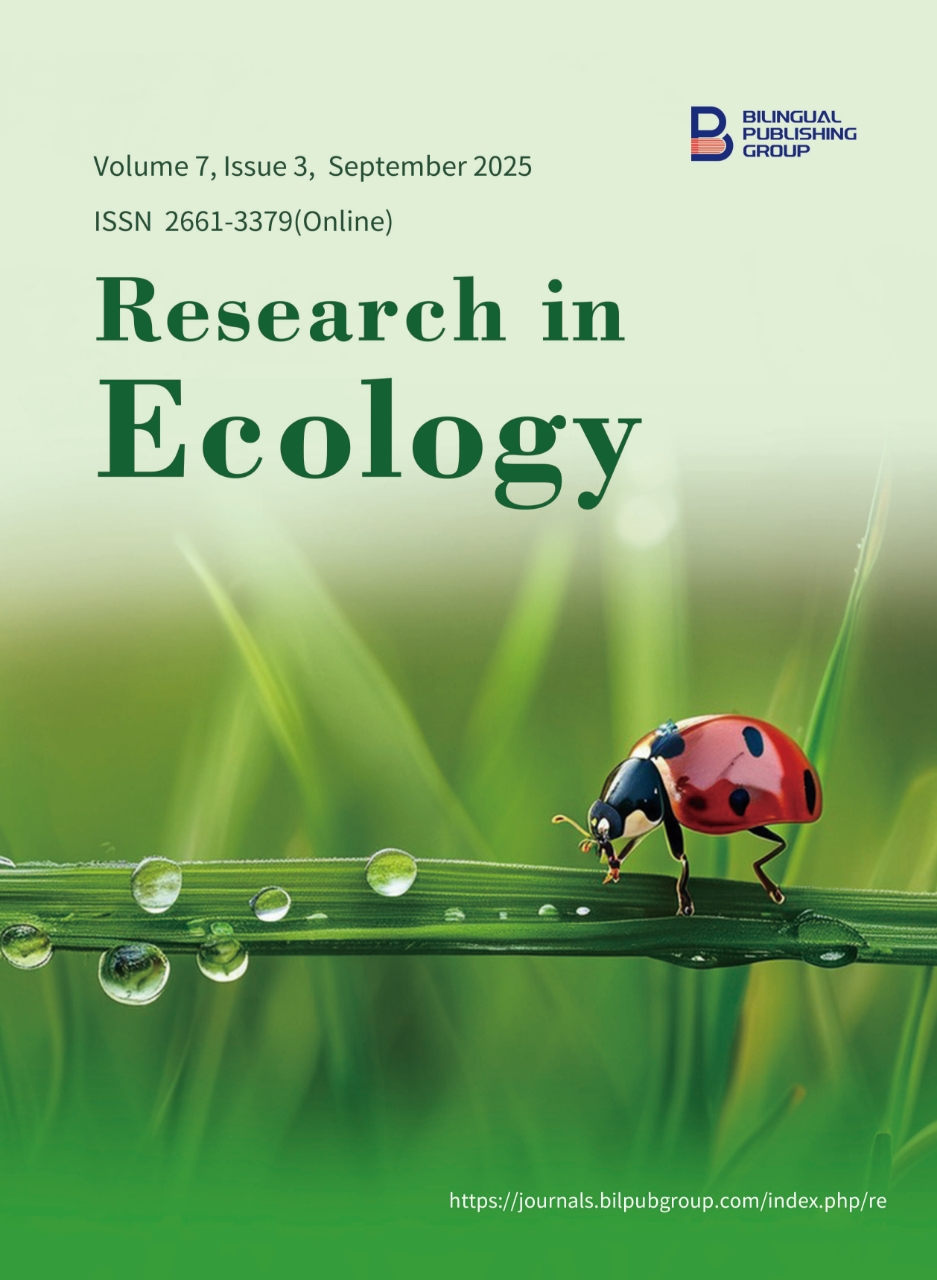
Distribution of Species of the Genus Astragalus L. in Kyrgyzstan by Habitat Type
DOI:
https://doi.org/10.30564/re.v7i3.9889Abstract
According to literary data, there are 189 species of the genus Astragalus that inhabit the territory of Kyrgyzstan. The distribution of species of the genus Astragalus (Fabaceae) was studied by taking into account their occurrence in soil-climatic and relief types of plant habitats in the mountainous territories of Kyrgyzstan. The materials were collected during organized research expeditions to natural areas of plant habitats. The occurrence of species was studied by well-known methods. As a result of such analysis we have made the following conclusions for the first time: in the flora of Kyrgyzstan there are 189 species of the genus Astragalus, they are representatives of 7 subgenera of this genus; species occur in 24 types of plant habitats with soil and relief features, taking into account the altitudinal regularity of taxa distribution in mountain phytocenoses; subgenuses and specific species characterized by broad, smallest and intermediate sizes of habitats were identified; groupings of plant habitat types on the territory of Kyrgyzstan characterized by the largest, smallest and intermediate indicators on the number of subgenuses and species of the genus Astragalus were identified. The botanical description of each species has been supplemented with new information about the species as a taxonomic unit. The materials of our work can be successfully used in the field of systematics, evolution and ecology of plants.
Keywords:
Species; Genus; Subgenus; Astragalus; Phytocenosis; Flora; Distribution; Highlands; Geographical RegionsReferences
[1] Rachkovskaya, E.I. (ed.), 1995. Vegetation of Kazakhstan and Central Asia (within the Desert Region): Explanatory Text and Legend on the Map. Komarov Botanical Institute, Russian Academy of Sciences: St. Petersburg, Russia. pp. 1–128.
[2] Ionov, R.N., Lebedeva, L.P., 2019. Plant world of Kyrgyzstan. Wildlife Research of Kyrgyzstan. 1, 26–35.
[3] Shukurov, E.J., Ionov, R.N., Lebedeva, L.P., et al., 2018. Plant and Animal Communities of Kyrgyzstan. Textbook for Universities. Adam University / Bishkek Financial and Economic Academy: Bishkek, Kyrgyzstan. pp. 1–110.
[4] Zhusupbekova, A.T., 2023. Flora of the Salkyn-Tor State Nature Park, located in the Inner Tien Shan Valley. News of the National Academy of Sciences of the Kyrgyz Republic. S7, 161–164.
[5] Kasiev, K.S., 2016. Change of vegetation belts of Kyrgyzstan as a consequence of global climate warming. Bulletin of Omsk State Agrarian University. 3(23). Available from: https://sciup.org/smena-rastitelnyh-pojasov-kyrgyzstana-kak-posledstvie-globalnogo-poteplenija-142199252
[6] Baitenov, M.S., 1977. Astragals of the Tien-Shan. Nauka: Alma-Ata, Kazakhstan. p. 143.
[7] Tojibaev, K.S., Beshko, N.Y., Azimova, D.E., et al., 2015. Specific features of distribution of species from sections Macrocystis, Laguropsis and Chaetodon of the genus Astragalus L. in the territory of the Mountainous Central Asian province. Turczaninowia. 18(2), 17–38. DOI: https://doi.org/10.14258/turczaninowia.18.2.3
[8] Kolanov, O., Mamatkulov, O.I., 2022. Peculiarities of distribution of species of leguminous plants (Fabaceae) on the territory of high mountains of Kyrgyzstan. In Proceedings of the international scientific and practical conference: Problems and Prospects of Studying the Biodiversity of Flora in Central Asia, Tashkent, Uzbekistan; pp. 117–124.
[9] Kolanov, O., Mamatkulov, O.I., 2022. Peculiarities of distribution of leguminous plant species of Kyrgyzstan in places located near natural water sources. In Proceedings of the international scientific and practical conference: Study, Conservation and Rational Use of the Flora of Eurasia, Almaty, Kazakhstan; pp. 337–345.
[10] Mamatkulov, O.I., Kolanov, O., 2015. Distribution of species of the genus Astragalus L. in natural zones of Kyrgyzstan. Osh State University Bulletin. 4, 161–164.
[11] Mamatkulov, O.I., Kolanov, O., 2016. Peculiarities of distribution of species of the genus Astragalus L. (Fabaceae) in the high mountains of Kyrgyzstan. Bulletin of KNAU Named after Skryabin. 5(41), 181–185.
[12] Mamatkulov, O.I., Kolanov, J.N., Erkebaeva, Z.N., 2024. Distribution of some species of the genus Astragalus L., belonging to different biomorphs, in southern Kyrgyzstan. Science. Education. Technology. 3, 44–51.
[13] Kolanov, O., Mamatkulov, O., 2024. Distribution of leguminous plant species in Kyrgyzstan by the nature of their habitats, considering mountain vertical zonation. E3S Web of Conferences. 537, 10003. DOI: https://doi.org/10.1051/e3sconf/202453710003
[14] Li, W., Tojibaev, K.S., Hisoriev, H., et al., 2020. Mapping Asia Plants: Current status of floristic information for Central Asian flora. Global Ecology and Conservation. 24, e01220. DOI: https://doi.org/10.1016/j.gecco.2020.e01220
[15] Karnaukhova, N.A., Zvereva, G.K., 2023. Status of coenopopulations of legumes (Fabaceae) on steppe pastures of the Altai Republic. Theoretical and Applied Ecology. 2, pp. 172–180. DOI: https://doi.org/10.25750/1995-4301-2023-2-172-180
[16] Komiljon, T., Karimov, F., Azimov, I., et al., 2018. Two new records for the flora of Uzbekistan from south-west Tian-Shan. Journal of Asia-Pacific Biodiversity. 11(3), 449–451.
[17] Definitel of Plants of the Kyrgyz SSR. 1957. Volume VII, p. 642.
[18] Definitel of Plants of Central Asia. 1981. Volume VI, p. 395.
[19] Lazkov, G.A., Sultanova, B.A., 2014. Cadastre of Flora of Kyrgyzstan. Vascular Plants. Bishkek. National Academy of Sciences of the Kyrgyz Republic: Bishkek, Kyrgyzstan. pp. 1–126.
[20] Belous, V.N., 2006. Landscape positions, ecological and phytocoenotic features and distribution of Astragalus sect. Xiphidium Bunge (Fabaceae) in Northern Asia. Problems of Botany of South Siberia and Mongolia. 5, 20–22. Available from: https://www.elibrary.ru/download/elibrary_43189159_93211495.pdf
[21] Erzhanov, E.T., 2016. Species of the genus Astragalus L. of Central Kazakhstan: geography, ecology of distribution and economic importance. International Scientific Review. 11(21), 13–14. Available from: https://www.elibrary.ru/download/elibrary_26847603_21446053.pdf
[22] Eskandari, S., Roofigar, A.A., Kaazempour-Osaloo, S., 2023. Foliar and pollen grain micromorphology of some species of Astragalus. Rostaniha. 24(2), 151–166.
[23] Ghahremani-Nejad, F., 2004. Value of trichome characteristics for the separation of bifurcating hairy Astragalus L. (Fabaceae) at the sectional level. Turkish Journal of Botany. 28(1–2), 241–245.
[24] Deroliya, P.K., Singh, H., Kumar, P., et al., 2022. Enumeration of Family Fabaceae from Sechu Tuan Nalla Wildlife Sanctuary, Chamba District, Himachal Pradesh (India). Journal of Botanical Research. 4(2), pp. 29–35. DOI: https://doi.org/10.30564/jbr.v4i2.4651
[25] Voronov, A.G., 1973. Geobotany. Higher School Press: Moscow, Russia. pp. 1–384.
Downloads
How to Cite
Issue
Article Type
License
Copyright © 2025 Orozbay Mamatkulov, Orozbay, Kursantbek Attokurov, Zhanan Erkebaeva

This is an open access article under the Creative Commons Attribution-NonCommercial 4.0 International (CC BY-NC 4.0) License.




 Orozbay Mamatkulov
Orozbay Mamatkulov






